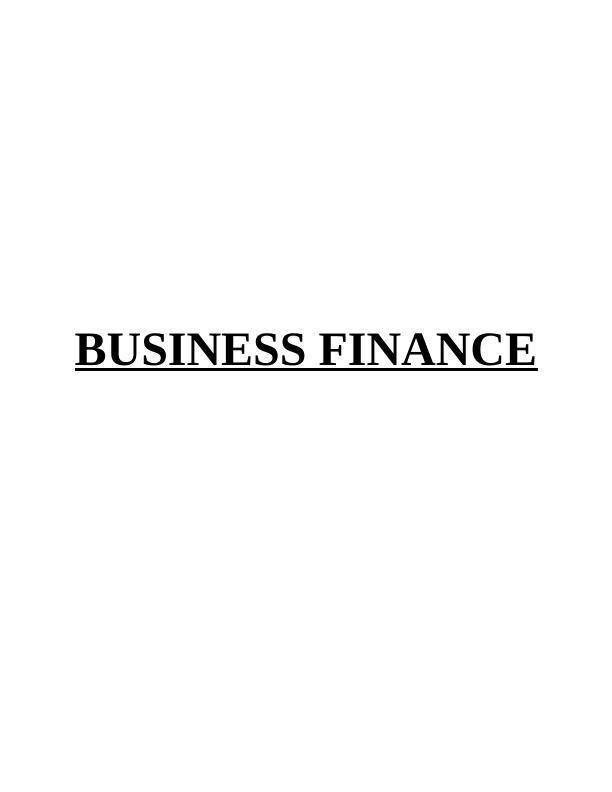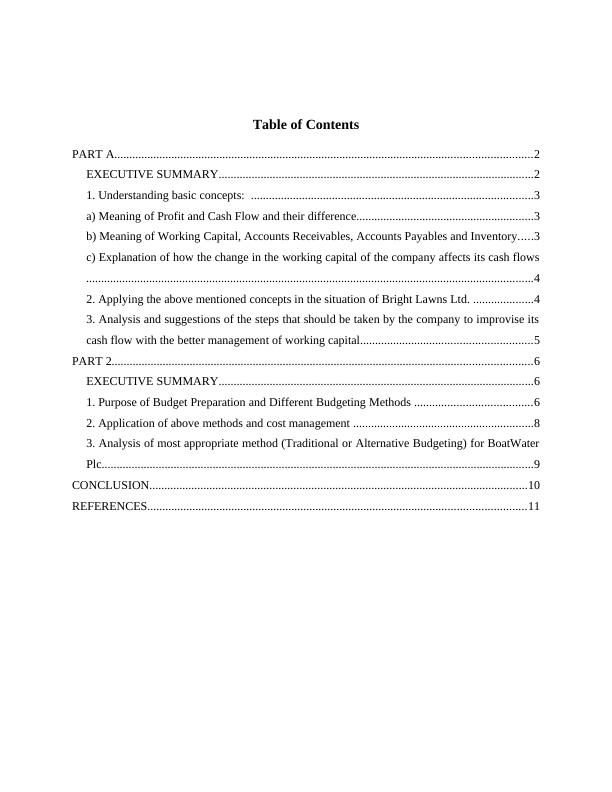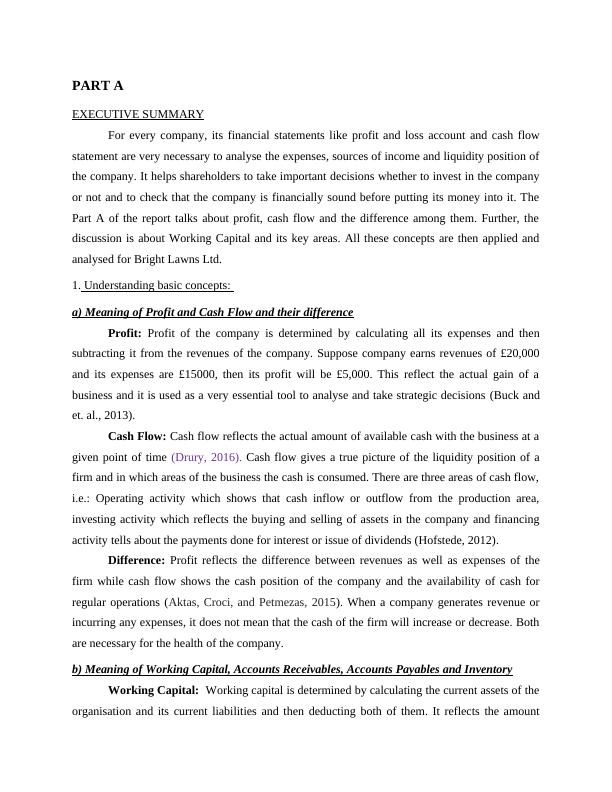Understanding Profit, Cash Flow, and Working Capital in Business Finance
Added on 2023-01-18
13 Pages3953 Words57 Views
BUSINESS FINANCE

Table of Contents
PART A...........................................................................................................................................2
EXECUTIVE SUMMARY.........................................................................................................2
1. Understanding basic concepts: ..............................................................................................3
a) Meaning of Profit and Cash Flow and their difference...........................................................3
b) Meaning of Working Capital, Accounts Receivables, Accounts Payables and Inventory.....3
c) Explanation of how the change in the working capital of the company affects its cash flows
.....................................................................................................................................................4
2. Applying the above mentioned concepts in the situation of Bright Lawns Ltd. ....................4
3. Analysis and suggestions of the steps that should be taken by the company to improvise its
cash flow with the better management of working capital.........................................................5
PART 2............................................................................................................................................6
EXECUTIVE SUMMARY.........................................................................................................6
1. Purpose of Budget Preparation and Different Budgeting Methods .......................................6
2. Application of above methods and cost management ............................................................8
3. Analysis of most appropriate method (Traditional or Alternative Budgeting) for BoatWater
Plc................................................................................................................................................9
CONCLUSION..............................................................................................................................10
REFERENCES..............................................................................................................................11
PART A...........................................................................................................................................2
EXECUTIVE SUMMARY.........................................................................................................2
1. Understanding basic concepts: ..............................................................................................3
a) Meaning of Profit and Cash Flow and their difference...........................................................3
b) Meaning of Working Capital, Accounts Receivables, Accounts Payables and Inventory.....3
c) Explanation of how the change in the working capital of the company affects its cash flows
.....................................................................................................................................................4
2. Applying the above mentioned concepts in the situation of Bright Lawns Ltd. ....................4
3. Analysis and suggestions of the steps that should be taken by the company to improvise its
cash flow with the better management of working capital.........................................................5
PART 2............................................................................................................................................6
EXECUTIVE SUMMARY.........................................................................................................6
1. Purpose of Budget Preparation and Different Budgeting Methods .......................................6
2. Application of above methods and cost management ............................................................8
3. Analysis of most appropriate method (Traditional or Alternative Budgeting) for BoatWater
Plc................................................................................................................................................9
CONCLUSION..............................................................................................................................10
REFERENCES..............................................................................................................................11

PART A
EXECUTIVE SUMMARY
For every company, its financial statements like profit and loss account and cash flow
statement are very necessary to analyse the expenses, sources of income and liquidity position of
the company. It helps shareholders to take important decisions whether to invest in the company
or not and to check that the company is financially sound before putting its money into it. The
Part A of the report talks about profit, cash flow and the difference among them. Further, the
discussion is about Working Capital and its key areas. All these concepts are then applied and
analysed for Bright Lawns Ltd.
1. Understanding basic concepts:
a) Meaning of Profit and Cash Flow and their difference
Profit: Profit of the company is determined by calculating all its expenses and then
subtracting it from the revenues of the company. Suppose company earns revenues of £20,000
and its expenses are £15000, then its profit will be £5,000. This reflect the actual gain of a
business and it is used as a very essential tool to analyse and take strategic decisions (Buck and
et. al., 2013).
Cash Flow: Cash flow reflects the actual amount of available cash with the business at a
given point of time (Drury, 2016). Cash flow gives a true picture of the liquidity position of a
firm and in which areas of the business the cash is consumed. There are three areas of cash flow,
i.e.: Operating activity which shows that cash inflow or outflow from the production area,
investing activity which reflects the buying and selling of assets in the company and financing
activity tells about the payments done for interest or issue of dividends (Hofstede, 2012).
Difference: Profit reflects the difference between revenues as well as expenses of the
firm while cash flow shows the cash position of the company and the availability of cash for
regular operations (Aktas, Croci, and Petmezas, 2015). When a company generates revenue or
incurring any expenses, it does not mean that the cash of the firm will increase or decrease. Both
are necessary for the health of the company.
b) Meaning of Working Capital, Accounts Receivables, Accounts Payables and Inventory
Working Capital: Working capital is determined by calculating the current assets of the
organisation and its current liabilities and then deducting both of them. It reflects the amount
EXECUTIVE SUMMARY
For every company, its financial statements like profit and loss account and cash flow
statement are very necessary to analyse the expenses, sources of income and liquidity position of
the company. It helps shareholders to take important decisions whether to invest in the company
or not and to check that the company is financially sound before putting its money into it. The
Part A of the report talks about profit, cash flow and the difference among them. Further, the
discussion is about Working Capital and its key areas. All these concepts are then applied and
analysed for Bright Lawns Ltd.
1. Understanding basic concepts:
a) Meaning of Profit and Cash Flow and their difference
Profit: Profit of the company is determined by calculating all its expenses and then
subtracting it from the revenues of the company. Suppose company earns revenues of £20,000
and its expenses are £15000, then its profit will be £5,000. This reflect the actual gain of a
business and it is used as a very essential tool to analyse and take strategic decisions (Buck and
et. al., 2013).
Cash Flow: Cash flow reflects the actual amount of available cash with the business at a
given point of time (Drury, 2016). Cash flow gives a true picture of the liquidity position of a
firm and in which areas of the business the cash is consumed. There are three areas of cash flow,
i.e.: Operating activity which shows that cash inflow or outflow from the production area,
investing activity which reflects the buying and selling of assets in the company and financing
activity tells about the payments done for interest or issue of dividends (Hofstede, 2012).
Difference: Profit reflects the difference between revenues as well as expenses of the
firm while cash flow shows the cash position of the company and the availability of cash for
regular operations (Aktas, Croci, and Petmezas, 2015). When a company generates revenue or
incurring any expenses, it does not mean that the cash of the firm will increase or decrease. Both
are necessary for the health of the company.
b) Meaning of Working Capital, Accounts Receivables, Accounts Payables and Inventory
Working Capital: Working capital is determined by calculating the current assets of the
organisation and its current liabilities and then deducting both of them. It reflects the amount

needed for the regular operations of an organization. Usually a positive figure is recommended
where current assets are higher than current liabilities. A good working capital means the
company is doing good on operational aspect (Cardoş, 2014).
Accounts receivables: They are also called debtors of the organization. The company
offers its goods and services on credit terms in which the customer can make the payment
afterwards. Debtors are the current assets for any organization.
Accounts Payables: They are also called as creditors of the organization. Companies can
also buy the goods and services on credit basis and decides to make the payment at some future
date. Creditors are the current liabilities of a firm.
Inventory: Company maintains some stock of the goods it sells in the market and that is
called as inventory which is the current asset of the firm. It may include raw materials, finished
as well as goods which are in process of manufacturing (Atrill, 2015).
c) Explanation of how the change in the working capital of the company affects its cash flows
Cash flow is directly affected by any change in the items of working capital, i.e. current
assets as well as current liabilities. So, there are two basic rules for it: i) Any increase in current
asset will decrease the cash flow and vice versa and ii) Any increase in current liabilities will
increase the cash flow with that amount and vice versa. All this is reflected in the operating part
of cash flow as +/- changes in the current assets as well as current liabilities. For example: If
Debtors of the firm are increased which reflects that company offered the goods on credit terms
and hence no cash is actually entered in the business, so it will be shown by deducting it from the
net income of the company (Pais and Gama, 2015).
2. Applying the above mentioned concepts in the situation of Bright Lawns Ltd.
Profit: Bright Lawns Ltd EBIT for the last year was £5 million which is quite good.
There has been reasonable demand for the goods as well services of Bright Lawns Ltd. And the
turnover was also more than £50 million. So, overall company is doing well in terms profitability
and revenues aspect as per the data available for the last year. But the challenge which the
company is facing is about the increasing debt i.e. earlier it was £16 million and now it is £18
million. The company must take steps to decide the best capital structure and should put efforts
to decrease its liabilities. Simmo thinks that they want more equity to reduce the overall debt but
this may be difficult for the company as raising money through equity will be expensive in this
case as they will ask for higher returns to invest in a company with increasing debt because of
where current assets are higher than current liabilities. A good working capital means the
company is doing good on operational aspect (Cardoş, 2014).
Accounts receivables: They are also called debtors of the organization. The company
offers its goods and services on credit terms in which the customer can make the payment
afterwards. Debtors are the current assets for any organization.
Accounts Payables: They are also called as creditors of the organization. Companies can
also buy the goods and services on credit basis and decides to make the payment at some future
date. Creditors are the current liabilities of a firm.
Inventory: Company maintains some stock of the goods it sells in the market and that is
called as inventory which is the current asset of the firm. It may include raw materials, finished
as well as goods which are in process of manufacturing (Atrill, 2015).
c) Explanation of how the change in the working capital of the company affects its cash flows
Cash flow is directly affected by any change in the items of working capital, i.e. current
assets as well as current liabilities. So, there are two basic rules for it: i) Any increase in current
asset will decrease the cash flow and vice versa and ii) Any increase in current liabilities will
increase the cash flow with that amount and vice versa. All this is reflected in the operating part
of cash flow as +/- changes in the current assets as well as current liabilities. For example: If
Debtors of the firm are increased which reflects that company offered the goods on credit terms
and hence no cash is actually entered in the business, so it will be shown by deducting it from the
net income of the company (Pais and Gama, 2015).
2. Applying the above mentioned concepts in the situation of Bright Lawns Ltd.
Profit: Bright Lawns Ltd EBIT for the last year was £5 million which is quite good.
There has been reasonable demand for the goods as well services of Bright Lawns Ltd. And the
turnover was also more than £50 million. So, overall company is doing well in terms profitability
and revenues aspect as per the data available for the last year. But the challenge which the
company is facing is about the increasing debt i.e. earlier it was £16 million and now it is £18
million. The company must take steps to decide the best capital structure and should put efforts
to decrease its liabilities. Simmo thinks that they want more equity to reduce the overall debt but
this may be difficult for the company as raising money through equity will be expensive in this
case as they will ask for higher returns to invest in a company with increasing debt because of

End of preview
Want to access all the pages? Upload your documents or become a member.
Related Documents
Understanding Financial Elements and Improving Cash Flow Positionlg...
|11
|3503
|93
Finance Report: Working Capital, Cash Flow, and Budgetinglg...
|9
|2837
|74
Business Finance: Working Capital and Budgeting Methodslg...
|13
|3473
|68
Business Finance: Elements of Financial Statements, Budget Formation, and Cost Managementlg...
|12
|3573
|89
Business Financelg...
|11
|3070
|41
Concepts that Affect Business Financial Resultslg...
|14
|3259
|37
